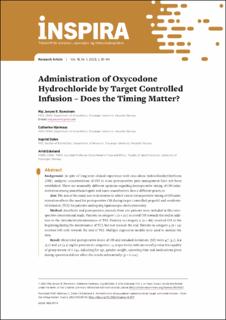| dc.contributor.author | Ramstrøm, Maj Jorunn | |
| dc.contributor.author | Hjelmaas, Catherine | |
| dc.contributor.author | Dalen, Ingvild | |
| dc.contributor.author | Eskeland, Arild | |
| dc.date.accessioned | 2024-04-08T12:01:32Z | |
| dc.date.available | 2024-04-08T12:01:32Z | |
| dc.date.created | 2024-01-17T15:15:31Z | |
| dc.date.issued | 2023 | |
| dc.identifier.citation | Ramstrøm, M.J.R., Hjelmaas, C., Dalen, I. & Eskeland, A. (2023) Administration of Oxycodone Hydrochloride by Target Controlled Infusion – Does the Timing Matter? Inspira, 18(1), 81-94 | en_US |
| dc.identifier.issn | 0809-9707 | |
| dc.identifier.uri | https://hdl.handle.net/11250/3125294 | |
| dc.description.abstract | Background: In spite of long-term clinical experience with oxycodone hydrochloride/OxyNorm (OH), analgesic concentrations of OH in acute postoperative pain management have not been established. There are assumably different opinions regarding intraoperative timing of OH administration among anaesthesiologists and nurse anaesthetists, hence different practices.
Aim: The aim of the study was to determine to which extent intraoperative timing of OH administration affects the need for postoperative OH during target-controlled propofol and remifentanil infusion (TCI) for patients undergoing laparoscopic cholecystectomy.
Method: Anesthetic and postoperative journals from 100 patients were included in this retrospective observational study. Patients in category 1 (n = 20) received OH towards the end in addition to the introduction/maintenance of TCI. Patients in category 2 (n = 66) received OH in the beginning/during the maintenance of TCI, but not towards the end. Patients in category 3 (n = 14) received OH only towards the end of TCI. Multiple regression models were used to analyze the data.
Result: Mean total postoperative doses of OH and standard deviations (SD) were 4.7 (3.1), 6.9 (5.1) and 4.7 (3.4) mg for patients in categories 1–3, respectively; with an overall p-value for equality of group means of 0.032. Adjusting for age, gender, weight, operating time and medications given during operation did not affect the results substantially (p = 0.012). In total during the per- and postoperative course, observed means (SD) of OH administered were 11.0 (2.9), 12.1 (5.5) and 9.0 (3.5) mg for patients in categories 1- , respectively (p = 0.039). The estimated group differences were only slightly affected by adjusting for patient and operational variables, however the result was no longer statistically significant (p = 0.057).
Conclusion: Our retrospective analysis suggested that intraoperative timing of OH administration affects the need for OH postoperatively after laparoscopic cholecystectomy with TCI anaesthesia. To reduce the total amount of OH, it may be beneficial to administer OH only towards the end of anaesthesia. | en_US |
| dc.language.iso | eng | en_US |
| dc.publisher | Cappelen Damm Akademisk | en_US |
| dc.rights | Navngivelse 4.0 Internasjonal | * |
| dc.rights.uri | http://creativecommons.org/licenses/by/4.0/deed.no | * |
| dc.subject | Oxycodone Hydrochloride | en_US |
| dc.subject | anestesiologi | en_US |
| dc.title | Administration of Oxycodone Hydrochloride by Target Controlled Infusion – Does the Timing Matter? | en_US |
| dc.type | Peer reviewed | en_US |
| dc.type | Journal article | en_US |
| dc.description.version | publishedVersion | en_US |
| dc.rights.holder | © 2023 Maj Jorunn R. Ramstrøm; Catherine Hjelmaas, Ingvild Dalen, Arild Eskeland | en_US |
| dc.subject.nsi | VDP::Medisinske Fag: 700::Klinisk medisinske fag: 750::Anestesiologi: 765 | en_US |
| dc.source.pagenumber | 81-94 | en_US |
| dc.source.volume | 18 | en_US |
| dc.source.journal | Inspira – tidsskrift for anestesi-, operasjon- og intensivsykepleiere | en_US |
| dc.source.issue | 1 | en_US |
| dc.identifier.doi | 10.23865/inspira.v18.3171 | |
| dc.identifier.cristin | 2228823 | |
| cristin.ispublished | true | |
| cristin.fulltext | original | |
| cristin.qualitycode | 1 | |

